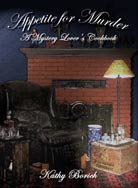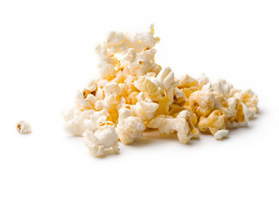Inglourious Basterds: Rote Grütze (Raspberry Dessert)
Year Released: 2009
Directed by: Quentin Tarantino
Starring: Brad Pitt, Eli Roth, Diane Kruger, Melanie Laurent, Christoph Waltz
(R, 152 min.)
Academy Awards (2010)
Actor in a Supporting Role: Christoph Waltz

"For revenge is always the delight of a mean spirit, of a weak and petty mind." Juvenal
It’s an adrenalin-pumping roller coaster of a film - one filled with the same heights and depths as the carnival ride. Fine acting shines next to ham-fisted farce; suspense dissolves into brutal bloodbaths, and appalling violence is not rejected but repeated on a grander scale. Enjoy it at your own risk, but leave your moral compass at home.
Director and screenwriter Quentin Tarantino proposes an alternate ending for World War II, or at least for Adolf Hitler and a few hundred of his Nazi cronies. Those exacting their retribution are Shosanna Dreyfus (Melanie Laurent), who has seen her entire family exterminated in German occupied France, and a band of Jewish American soldiers led by Southern, part Apache Jew, Lt. Aldo Raine (Brad Pitt). Both plans hinge on taking down the leaders of the Third Reich in a small theater in Paris.
While Shosanna has been biding her time running the small cinema, Lt. Aldo Raine and his little troupe have been quite busy. As anyone who has seen the trailer can tell you, each of his men has a mission – to spread terror among the German troops, their chief means of which is to exterminate as many as possible and take a minimum of one hundred scalps each. Of course, each time Lt. Raine uses the ancient custom of allowing one maimed soldier to live in order to tell about the gruesome deaths.
The bloody scalps are lining up as nicely as lobbyists in Congress , and the “Basterds” are doing a pretty good job of stirring up their little pot of fear, dread, and terror. Particularly frightening is the Jew Bear, played by 37–year-old writer, director, and occasional actor Eli Roth.
His specialty is battering the brains out of his foes with his trusty baseball bat, an act we see graphically demonstrated on one German soldier who refuses to give up his countrymen’s position to his captors. In normal circumstances one might see this soldier’s refusal as heroic, but Tarantino doesn’t allow the audience much time to ponder that irony, moving dexteriously to the baseball bat and its dubious “home-run.”
Roth is particularly enthusiastic about Tarantino’s writing:
I think he's achieved a new level of writing with this movie. He's writing like Arthur Miller, like a great Broadway playwright. I told him that students are going to be performing these scenes in acting classes for the next 50 years.
Why do I wonder if many of those who tut-tutted about the enhanced interrogation methods used on the mastermind of the infamous terror attack of 9-11, now seem perfectly gleeful to soak up the graphic and brutal violence meted out to German soldiers and civilians alike in Tarrantino’s film? And does anyone ever bring up the fact that many German soldiers were not necessarily Nazis, or if they were, it was to choose that affiliation or die?
Strangely enough, there are a some scenes that are exquisite – the acting and suspense top rate. One such scene involves Col Hans Landa (Christoph Waltz) questioning a French farmer who he thinks is hiding a neighboring Jewish family. He is courteous to a fault, but his malevolent resolve and wiley machinations are just below the surface.
Another such scene is a rendezvous between some of Raine’s men who speak German and the famous German actress Bridget Von Hammersmark (Diane Kruger) who is on their side. Unfortunately, the isolated tavern chosen for the meeting is filled with some German soldiers and a Gestapo agent who joins them at their table. Again there is the the social banter, the guarded questions turned away with wit and laughter, and beneath it all, the churning stomaches and cold sweat.
Yet as good as these scenes are, they are essentially derivative – Tarantino recreating scenes that have been done before. One only needs to contrast these with other films that ring with originality and authenticity, such as the classic 1969 Army of Shadows about the lonely desperation of the the French Resistance; The Boy in the Striped Pajamas, an unflinching portrait of an unlikely friendship that flourishes during World War II, or Before the Fall, a study of the repercussions of a flawed ideology upon the individuals who espouse it in early Nazi Germany. All these films have very believable characters,and unlike Tarantino’s polemic, not every German is an evil Nazi lusting for the Final Solution.
What I think is operating here is a form of displacement, the psychological term describing the mind’s propensity to deflect the rage felt against a dangerous or unacceptable source to one that is safe and acceptable.
The rage that most American felt when the World Trade Center Towers fell was tolerated for only a short time. Too soon we were told to move on, to study the reasons we might have merited this atrocity. Beheadings and burned bodies of soldiers were not to permeate our consciousness. Islam was a religion of peace after all.
Yet, the rage is still there and so it seeks safer targets. With Germany in the forefront of censuring its Nazi past, the perfect target has emerged. It is no coincidence, in my opinion, that the final scene of Inglourious Basterds involves the highest eschelon of the Third Reich trapped in a burning building. Yes, this is a literal holocaust revisited on those that unleashed it upon their Jewish bretheren, but it is also a reenactment of the terrible conflagration that occurred behind the fixed glass walls of the World Trade Center.
Perhaps when we can make a film that examines our current enemies without blinking, we can avoid the puerile excesses that Taratino indulges in here.
—Kathy Borich
Film-Loving Foodie
One of the better scenes of the film occurs when Shosamma Dreyfus meets the Nazi who slaughtered her family three years earlier. She knows who he is, but she has hidden her Jewish roots with a new identity. Colonel Landa orders a strudel for the two of them, coffee for himself and milk for her. Of course, it was fresh milk that Landa drank in the kitchen above her as Shosanna and her family cowered beneath the floor boards in their hiding place.
Somehow, Shosanna eats the strudel – another reminder of Germany’s occupation of her French homeland – and even manages to down the milk, but each bite and every sip is a monument to her resolve. It is only after the colonel has departed that she reacts to these devastating memories. And it is probably then that she hatches her plan for revenge.
I offer not one but two very good recipes for Apple Strudel from past posts.
For today I will offer another delicious, though hardly known German dessert. I had never heard of it until my sister-in-law, Beverly, served up this delicious raspberry/cream concoction this summer. It is called Rote Grütze, a kind of red pudding or sorbet served atop custard or whipped cream.
Light and delicious, it is not unlike a raspberry dessert from that foodie film heaven, Julie and Julia.
Just the thing to wash away those vile images from Tarantino’s bloodbath.
Rote Grütze (Raspberry Dessert)
- 1 pkg. Jell-o Tapioca pudding
- ¾ cup water
- ½ cup burgundy wine
- 1 pkg (10oz.) Birds Eye Quick Thaw red raspberries
Combine Tapioca, water and wine in saucepan. Add frozen raspberries. Cook and stir over med. heat until mixture comes to a full boil and is slightly thickened. Cook 15-20 min., stirring a few times. Pour into individual dessert dishes. Chill 3 hrs. or overnight. Serve with whipped cream or basic custard sauce. 4 servings.
Recipe Source: Beverly's Kitchen



 Rainy Day Rentals
Rainy Day Rentals